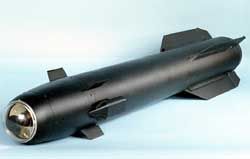Directorate Officer

Image Source: here
Intent: develop a non-lethal means of subduing larger creatures
Development Thread: Missiles and Monsters
Manufacturer: Lucerne Labs
Model: LLT-7 Calmant-class Missile
Affiliation: Open Market
Modularity: No
Production: Mass-Produced
Material: Plasteel fuselage, chemical propellant, various avionics, Drem-C
Classification: Animal Control Device
Size: Standard Starfighter-grade concussion missile
Length: 1.70 meters
Weight: 60 Kg
Ammunition Type: Missile
Ammunition Capacity: 1 Drem-C Application Device (10 Kilograms of Drem-C)
Effective Range: 1 kilometer
Rate of Fire: Single
Special Features:
-Drem-C Application device
Strengths
-can subdue large creatures with a minimal amount of damage
-Targets can be captured alive and relatively undamaged
Weakness:
-some targets may suffer from overdose, and subsequent death or persistent injury if used improperly
-Overspecialized compared to other munitions
Description: The LLT-7 Calmant-class Missile is officially marketed as animal control device to local governments where large, dangerous animals are common, such as Onderon or Dathomir, as well as various spacer and fringe elements worried about encountering Colossus Wasps or Space Slugs in the depths of space. Unofficially, the weapon is more often purchased for protection against various Sithspawn that have made a relatively recent comeback to the galaxy in large numbers under the One Sith.
At a quick glance, the Calmant-class appears to be a normal concussion missile because the Calmant’s is derived from the same warhead. This also allows the Calmant to be fired from standard Starfighter-grade concussion missile launchers with little to no modification needed to the launcher. The rear of the plasteel fuselage houses a simple, but highly reliable solid fuel chemical rocket optimized for maneuverability, not high speed like traditional concussion missiles; the designers believed tracking their target would be important that outrunning it. This motor is guided by a dual-seeker target acquisition software using both millimeter-wave radar and uncooled imaging infrared sensors to form a composite image of the target and tracks it to the best of its abilities (this is a slightly less advanced version of the system used on the real life GBU-53, which also uses a laser to add a third sensor). Typically, this accuracy is to within a meter, thanks to the missile’s relatively slow speed, high maneuverability, and composite sensors. Under sensor jamming, the missile’s accuracy falls down to three meters. This tracking accuracy makes the Calmant really only suitable for use on creatures significantly larger than humans (bantha sized or larger) except in the most skilled hands or in unusual situations (such as a creature immobilized by a net).
Where the warhead is on a concussion missile, the Calmant has a large hypodermic needle made out of mirrsteel surrounded by a ring of smaller, barbed durasteel needles set before a plasteel reservoir and capacitor-powered Drem-C charging unit. To prevent damage during flight or storage, this Drem-C application device is covered by a plasteel shell until right before it hits its target, when the panels fall off the warhead. The exposed needle then pierces through the target’s dermis and any outer coverings and into its flesh. Then, while the large hypodermic needle discharges 10 kilograms of Drem-C into the target, the smaller needles pierce the target’s flesh to help stabilize the hypodermic needle in the target’s body even if the target is thrashing around trying to remove the projectile from its body. Because of the missile’s velocity, the Drem-C is pushed into the target very quickly and then is generally no chance to stop its delivery once the missile hits. While attempts were made to make Calmant safer by reducing its velocity, it was then found that such low velocities did not allow the needle to reliably pierce into the targets’ flesh.
While the Calmant is marketed as a one-size fits all weapon, the missile does not perform the same against all creatures. Smaller creatures are generally more susceptible to being knocked out by a single Calmant (though their size often makes them harder to hit), while larger creatures will often need multiple hits to fully subdue. On larger creatures, even a single hit will often cause localized impairment to the creature, such as limb going numb, or low-grade detrimental effects across the creature’s body depending on the location of the hit and the creature’s anatomy. The duration of the Drem-C’s effects on creatures vary by size and anatomy, but typically creatures around the size of a bantha are unconscious for several hours after they are hit with one missile. It is important to note that it is possible to kill a creature by overdose, especially if the creature is on the smaller size, or multiple missiles are used on a single target.
While the LLT-7 Calmant is primarily designed to be launched from starfighters and other small ships, the missile can also be adapted to be fired from standard handheld missile launchers like the PLEX with a little work. Lucerne Labs hopes that the missile will become a popular alternative to simply blowing up pesky creatures with typical concussion missiles or proton torpedoes because this specialized missile will be more accurate and will cause far less collateral damage if it misses. Some buyers have also expressed interest in the Calmant for capturing larger creatures for later use or relocation, or to be able to harvest individual pieces of the animal without ruining it (such as pelts, various fluids, etc).













